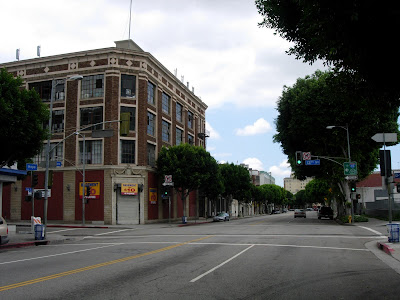Many thanks to the Kitty Packard Pictorial blog for the heads up to the Jules Verne Festival event honoring legendary actor Tony Curtis. On Saturday, June 13, 2009 the Jules Verne Festival was all about Tony Curtis. Beginning at 2:30pm was a screening of the Curtis film Houdini at the historic Million Dollar Theater in downtown Los Angeles, followed by a dinner with Curtis at the Los Angeles Athletic Club, and back to the Million Dollar Theater for a special 50th anniversary screening of the hilarious film Some Like it Hot. My fiance Zinnia and I were fortunate enough to attend the evening events. Here are some photos from that night.
The screenings of Houdini and Some Like it Hot were held at the historic Million Dollar Theater. I wasn't able to make the Houdini screening but arrived at the theater in time to catch the party shuttle from the theater to the Los Angeles Athletic Club where the dinner was to be held.
Out front of the theater there were many old classic cars lined up. I especially liked this green Plymouth. They certainly don't make cars like they used to. Also, you may recognize that building from my earlier post on Double Indemnity film locations. That's the historic Bradbury building.
Once the Houdini screening let out the shuttle took us to the Los Angeles Athletic Club for dinner. There was champagne, shrimp, sushi, ice cream sundae bar and all sorts of delicious food. For dinner entertainment, the escape artist Curtis Lovell II performed Houdini's straight-jacket escape stunt. Tony helped to secure the straps of the straitjacket.
 Assistant steps in to help strap in Lovell
Assistant steps in to help strap in Lovell Lovell attempting to break out of the jacket while Curtis watches.
Lovell attempting to break out of the jacket while Curtis watches. Robby, Zinnia, and Tony Curtis
Robby, Zinnia, and Tony CurtisAfter the escape stunt Tony Curtis started to sign his memoirs. Curtis was very generous and took time to sign autographs and take photos with everyone in the room. Some time you meet celebrities and its disappointing to learn how big their egos have become. Not Curtis. He's a class act. I felt the same way when I met actor Robert Wagner for the first time a few months back. Both men seem to have an appreciation for their success and the hard work it took to get to their level. They both seem to have a respect for their fans knowing that it's because of them in part that they had such successful careers.
Thanks Tony for the autograph and photo!
 Tony Curtis honored by City of Los Angeles
Tony Curtis honored by City of Los AngelesNext we hopped back on the shuttle to the Million Dollar Theater for the 50th anniversary screening of Some Like it Hot. Jean-Christophe Jeauffre and Frederic Dieudonne, the founders of the Jules Verne Festival were the host for the night. After they showed a film reel with many entertaining clips from Curtis's many films the City of Los Angeles presented Curtis with an award for his many contributions to the city.
 Frederic Dieudonne, Tony Curtis, Jean-Christophe Jeauffre
Frederic Dieudonne, Tony Curtis, Jean-Christophe JeauffreTony Curtis came out on stage and shared many of his life stories. And even though Tony Curtis is getting up there in age (he just turned 84 on June 3) he is still an amazing storyteller. His stories were told with wit and perfect comic delivery. One of my favorite stories that Curtis told was about when he first met actress Marilyn Monroe for the first time. Curtis was a new actor under contract at Universal, only 22 years old, and he was asked by one of the Universal guards to give another young actress who was not under contract a ride back to her hotel. Curtis looked at the actress and started to describe her: "she wore a dress that was a little above her knee, orange and yellow in color, cinched in where her waist was (and)... her bosoms were remarkable!" Curtis turned back to the guard and said, "I would be privileged to give her a ride."
Another a funny story was told by Jean-Christophe. At another event in Paris honoring Tony Curtis, a French reporter asked the actor, "Mr. Curtis, you are getting older and you have a wife who is almost half your age. Aren't you worried about having sex with a woman her age?" Curtis replied without skipping a beat, "If she dies, she dies."
 Tony Curtis reaches out to Frederic Dieudonne
Tony Curtis reaches out to Frederic Dieudonne Tony Curtis is presented the Jules Verne Award
Tony Curtis is presented the Jules Verne AwardAfter sharing some stories Jeauffre and Dieudonne brought up on stage two of Curtis's co-stars from Some Like it Hot, Tracy Moss and Marian Collier, to present him with the Jules Verne Award. The actresses were members of the all-female band in the film.
 Tony Curtis with Some Like it Hot co-stars Tracy Moss and Marian Collier
Tony Curtis with Some Like it Hot co-stars Tracy Moss and Marian CollierAfter the award presentation it was time to start the film. Some Like it Hot played to a full house and the theatre was filled with laughter from start to finish. The film holds up pretty well and is a true classic with many great performances.




























































 Kim Novak house as it appears in the film. 512 Tigertail Rd.
Kim Novak house as it appears in the film. 512 Tigertail Rd. Kim Novak house as it appears today.
Kim Novak house as it appears today. Kim Novak leaving her house as seen in the film.
Kim Novak leaving her house as seen in the film. Kim Novak's neighbor's house as it appears today.
Kim Novak's neighbor's house as it appears today.






















